
By the time Justin Timberlake took the stage at the 2018 Super Bowl halftime show, Ryan Green was deep into his third bucket of IPAs at a local Vegas haunt.
Maybe it was the buzz of the bitter hops, or the babel of the bar, or the pop star’s hypnotic timbre — but Green was feeling “tremendous.” At some point, he wandered into the full-capacity bathroom and Googled Timberlake’s tour dates on his phone.
On a wet countertop, amid a sea of Brady jerseys with full bladders, he splayed out the contents of his wallet and secured two tickets — $165 apiece — to see JT in the flesh.
“I woke up the next day and found a confirmation email I didn’t remember,” he says.

Green is not alone.
We recently ran a survey of more than 2,000 alcohol-consuming American adults and found that drunk shopping is an estimated $45B per year industry.
Who’s doing all this drunk shopping? What are they buying? Where are they buying it? And is e-commerce streamlining the process for a new generation of tipsy consumers?
A few key findings:
- 79% of alcohol consumers have made at least one drunk purchase
- $444: Average annual spend per drunk shopper
- Clothing and shoes are the most common drunk purchase
- Amazon is the drunk shopping platform of choice
Let’s take a deeper look.
Who drunk shops?
First, a quick note on methodology: The information presented here is based on a survey of 2,174 alcohol-consuming readers of The Hustle between March 11-18, 2019. Our average respondent is 36 years old, has an income of $92k (more than double the national average), and skews a bit more male (53%) than female (47%). The data presented here is by no means definitive or conclusive; nonetheless, it still provides an interesting snapshot of the drunk shopping market.
Overall, 79% of all alcohol-consuming respondents have made at least one drunken purchase in their lifetime — though this varies a bit based on demographics.
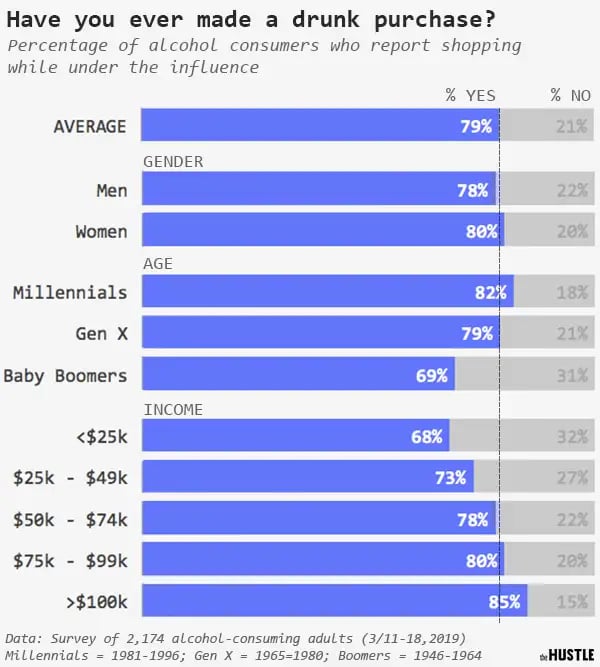
Women (80%) are slightly more likely than men (78%) to drunk shop. This makes sense since women generally shop more than men — especially online.
Drunk shoppers also tend to be younger. Millennials outrank baby boomers by 13%, which might be attributed to the rise of e-commerce (we’ll get to this later).
Certain professionals also seem to be more inclined to shop drunk than others. We limited our data to jobs with the highest response rates then parsed out the 5 industries that are most and least likely to shop under the influence.
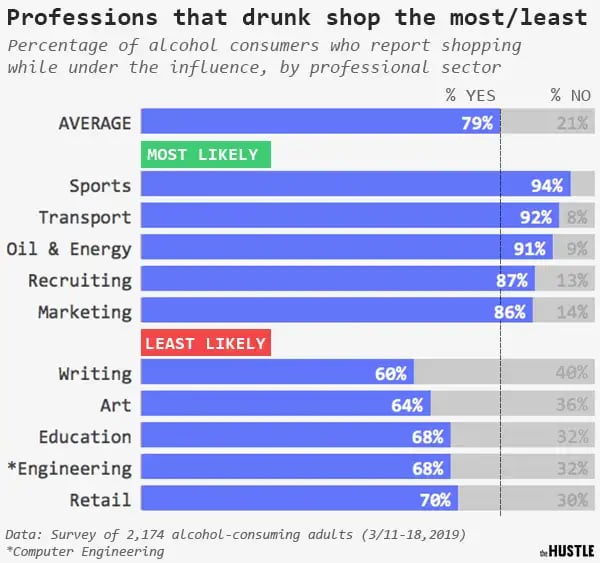
Given the inseparable bond between sports and beer, the list topper isn’t too surprising. Nor are the highly social jobs of recruiting and marketing. What’s slightly more concerning is that transportation and oil & energy (sectors known for long, often solitary work hours) boast near-universal drunk shopping habits.
Writers, editors, and artists — tortured, oft-inebriated chroniclers of the human experience — are actually far less likely to drunk shop. A possible explanation is that these jobs fall into lower-income brackets… but we’d like to think they’re just anti-consumerists.
Computer engineers prefer retiring by 30 to purchasing 3-foot-long gummy worms on Amazon after downing 14 Tequila Sunrises.
Which leads us to our next data point: What do people drink when shopping?
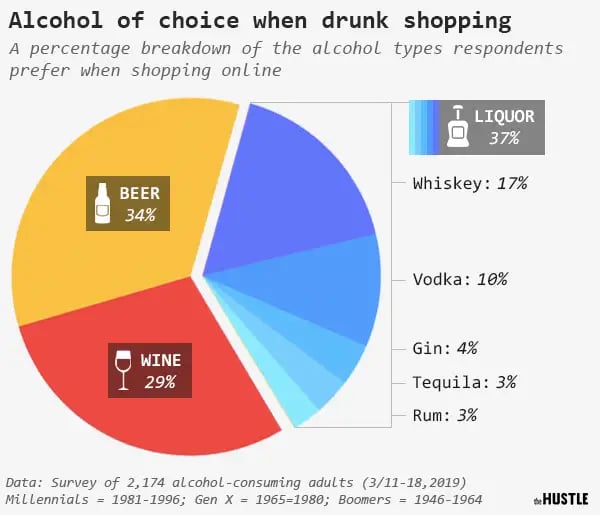
Beer, wine, and liquor seem to bear equal responsibility for terrible decision-making.
However, these percentages vary widely by gender: 45% of men prefer beer, and 50% of women prefer wine. On the liquor front, 26% of men prefer whiskey, while 13% of women prefer vodka.
There is also a correlation between the average number of drinks consumed per week and a consumer’s propensity to drunk shop.
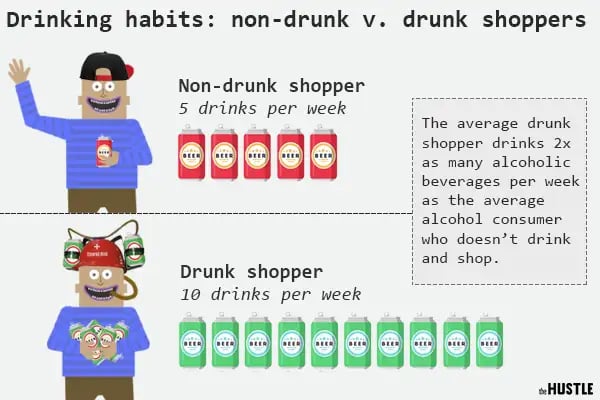
Drunk shoppers consume 10 drinks per week, double the consumption of drinkers who don’t shop under the influence.
Both of these figures are within the range of what the National Institute of Alcohol Abuse and Alcoholism considers “low-risk” drinking (for women, this means no more than 7 drinks per week; for men, no more than 14).
How much do people spend?
Our average respondent reports dropping $444 per year on drunk purchases — from life-size cut-outs of Kim Jong-un to 30-pound bags of Idaho potatoes.
A little back-of-the-napkin math gives us a rough estimate of the drunk shopping market at large: There are ~130m alcohol-consuming adults in the US. In our survey findings, 79% of alcohol-consuming adults shop drunk at an average annual spend of $444. Assuming these rates hold true at a national level (purely speculative), drunk shopping is a ~$45B per year market.
Extrapolating this further, we determined the average lifetime spend on drunk purchases is $4,187 — good for a total drunken expenditure of nearly half a trillion dollars.
But not every drunk shopper pulls his or her weight.
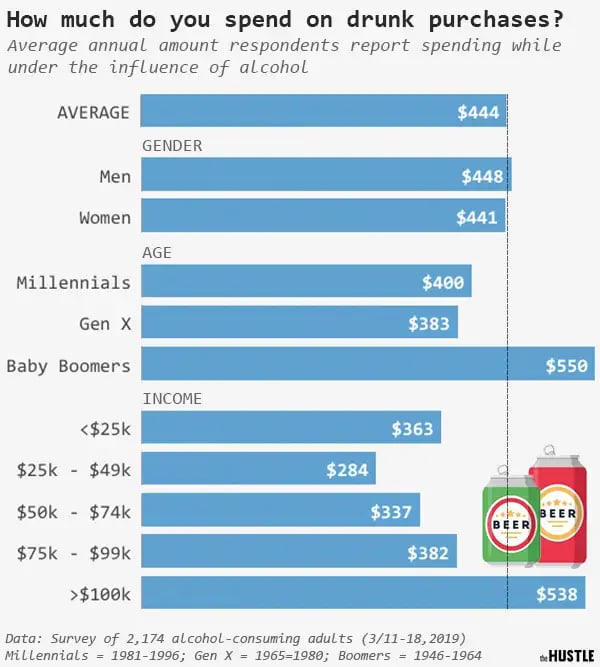
While women drunk shop more than men, men spend more money. Though, considering the gender pay gap, women are likely spending a higher percentage of their salary on drunk purchases than men.
We also see a reversal in the age category: While millennials are more likely to drunk shop than baby boomers, older drunk shoppers outspend their younger counterparts by an average of $150 per year (roughly the cost of a high-end lawn chair and a bullhorn for yelling at kids who are on the lawn).
But the biggest variance in spending comes at the professional level.

Workers in the fashion industry love to shop — apparently, not just when they’re sober. They spend $949 per year, more than double the overall average.
The fashionistas who responded to our survey reported buying all kinds of questionable things, ranging from $500 dress shoes to “a two-person sweatshirt that has Santa sitting on a toilet.”
There is also a tinge of irony in retail ($294 per year) bottoming out the list, considering they’re the master peddlers of drunk purchases.
Trends in drunk spending even vary geographically. In the map below, blue represents states under the average, orange depicts the average range, and red shows areas that exceed it.
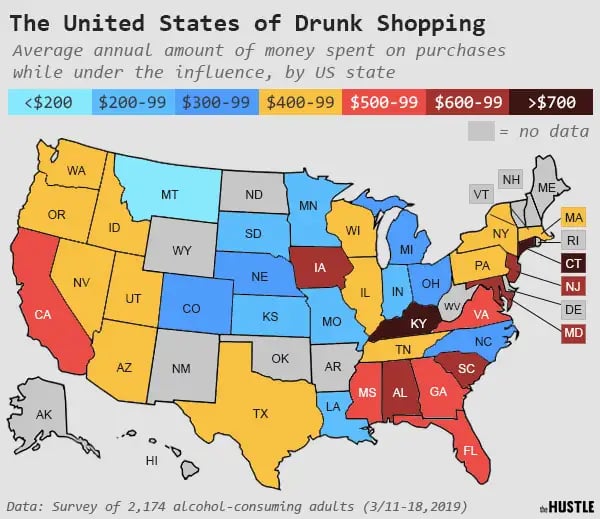
Kentuckians top the charts with a $742 annual spend. In fact, the entire South — a region known for its fine bourbon — is a blanket of red. California, the country’s wine capital, is the lone over-achiever on the otherwise mediocre West Coast.
This bears little semblance to the CDC’s analysis of the heaviest binge-drinking states (in fact, it’s almost opposite). But it shows that the economics of drunk shopping is a more complex matter than simply parsing out where people drink the most.
What are people buying with all this moola?
Okay — we’ve determined who is doing the drunk shopping, and how much they’re spending. But what the hell are they buying? Do drunk purchases have a distinctively ridiculous flair?
First off, the bulk of this drunk shopping is done online — and it’s not surprising which platform comes out on top.

Amazon, the land of Nic Cage pillows and earthworm jerky, is used by 85% of all drunk shoppers. (Congrats, Bezos: You can now sext under the “King of Drunk E-commerce” moniker.)
It also needs to be noted that a sizeable minority of shoppers (12%) enjoy getting pleasantly pickled and buying crocheted socks for their cats on Etsy. The artsy-fartsy platform holds up surprisingly well against its much bigger rivals here.
Turning to the most-purchased item categories, this makes some sense.

Clothing and shoes are the goods of choice while drunk.
Studies have shown that people who base their self-worth on appearance are more likely to imbibe alcohol, so there is some tenuous linkage here. But this also ties in with the rapid rise of the direct-to-consumer fashion industry.
Entertainment (movies, games) and tech gadgets are also popular choices — though the party train seems to abruptly halt at software (if you’ve purchased a copy of Microsoft Excel drunk, we need to talk.)
Drunk buys are certainly not limited to these categories. We asked our readers to send us their weirdest purchases, and they did not disappoint. A small selection:
- 200 pounds of fresh, 10-foot tall bamboo
- A World War 2-era bayonet
- A full-size inflatable bouncy castle (“For my living room”)
- A breast pump (“I’m a dude”)
- A splinter that was removed from the foot of former NBA Star, Olden Polynice
- The same vest Michael J. Fox had on in Back to the Future
- A $2,200 pair of night vision goggles
- Tons of international fights (Azerbaijan, Iceland, Ukraine, Tunisia)
- An NRA membership
- A trilogy of Satanic religious books
Given the absurdity of these items, we were somewhat shocked to learn that very few people report experiencing regret.

Drunk shoppers readily admit that e-commerce has amplified their drunk shopping habits. Yet only 20% of folks return drunk buys — and 6% feel repentant about them.
“To be honest, they’re almost always stupid buys, but the humor factor outweighs the stupidity,” one drunk shopper said of his habit in a survey response, “I guess it’s a privileged way to look at consumption…But how many people can say they own a personalized Chia Pet?”
Brands are taking advantage of your drunkenness
Retailers go to great lengths to capitalize on your drunken stupor and capture a chunk of this ~$45B market.
As we previously wrote about, the online shopping experience is already peppered with psychological trickery to make us buy things we don’t need. Add in alcohol (which reduces our inhibitory control, self-restraint, and decision-making abilities) and you’ve got a recipe for disaster.
Many online shops actively prey on drunk shoppers with late-night flash sales. As the president of the online retailer, Gilt Groupe, explained to the NYT in 2011: “Post-bar, inhibitions can be impacted, and that can cause… healthy impulse buying.”
This is to say: Have fun and enjoy yourself, but be wary of the predatory nature of it all. Unless, of course, you’re the kind of person who can utilize 7 tie-dye Snuggies.
Correction: A previous version of this article included “Alaska” in a list of international flights. This has been corrected.

